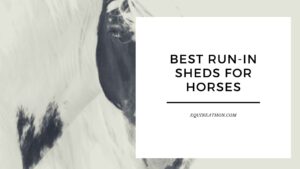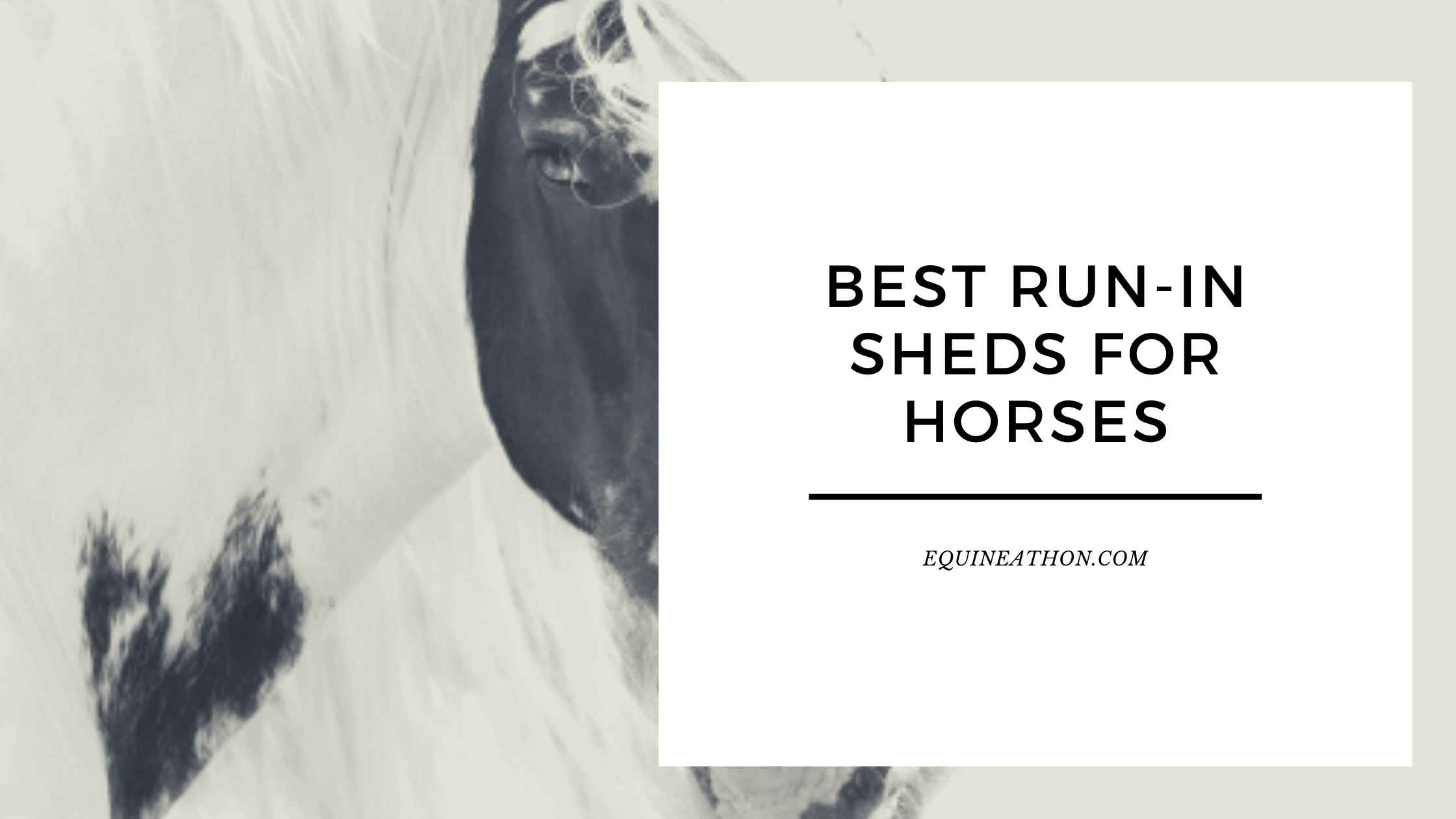The Best Run-In Sheds for Horses: A Comprehensive Guide
Run-in sheds, also known as loafing or free-access shelters, are essential for horse owners who wish to provide their equines with protection from the elements while they are out in the pasture.
These structures offer shade from the sun, refuge from the rain, and shelter from the cold, ensuring the well-being of your beloved horses.
But with numerous options available in the market, how do you determine the best one? Let’s dive into the innovative, yet factual world of run-in sheds.
The Importance of Run-In Sheds
Before deciding on the best shed, it’s essential to understand their role. Horses, by nature, seek shelter from harsh weather conditions.
Whether it’s intense sun, pouring rain, or biting cold, having access to a shelter allows horses to regulate their body temperatures more effectively, reducing the risks of health issues.
Material Matters
The construction material plays a crucial role in the durability and safety of the shed.
- Wood: Traditional and offers a natural aesthetic. It’s sturdy but requires regular maintenance to prevent rot and insect damage.
- Metal: Galvanized steel or aluminum structures are durable, resistant to pests, and often more affordable. However, they might not provide as much insulation as wooden structures.
- Poly: Modern run-in sheds made of heavy-duty poly material are gaining popularity. They’re durable, weather-resistant, and often have UV protection.
Design Innovations
Modern run-in sheds come with various innovative designs:
- Adjustable Ventilation: Features like adjustable roof vents or louvered walls allow for better airflow, essential during hot summer months.
- Modular Systems: Some sheds allow for expansion. As your herd grows, you can add more sections.
- Storage Compartments: Integrated tack or feed storage can be a boon, especially if you have limited space.
Size and Accessibility
The size of the shed should correlate with the number of horses you have and the space they need.
A general rule of thumb is to provide at least 100 sq. ft. for the first horse and an additional 60-70 sq. ft. for each additional horse.
Portability
Consider a portable run-in shed if you anticipate needing to move it. Many lightweight designs can be transported around your property with relative ease.
Foundation and Flooring
A solid foundation is crucial. Most owners opt for gravel as it provides excellent drainage. However, innovations like rubber mat flooring can offer more comfort for the horses and ease of cleaning.
Safety First
Ensure the design has no sharp edges, protruding nails, or any other hazards. Also, consider a kickboard lining inside the shed to protect the walls from horse kicks.
Top Picks for Best Run-In Sheds
- ShelterLogic: Known for its durable and portable designs. Their polyethylene cover provides both shade and protection from rain.
- K&K Horse Shelters: Offers solid wood construction with a variety of sizes. Their sheds also feature an innovative modular design.
- DuraShelter: Focuses on galvanized steel structures that are both durable and affordable.
Cost Considerations
While the safety and comfort of your horses are paramount, it’s essential to consider your budget. Often, customization or additional features can increase the price. It’s a balance between what you desire in a shed and what you’re willing to invest.
Maintenance
No matter the material or design, regular maintenance, such as checking for damages, cleaning, and ensuring the structure remains stable, is crucial for the safety of your horses.
In Conclusion
Finding the best run-in shed involves a mix of understanding your horses’ needs, recognizing the innovations available, and matching them to your budget. With proper research and attention to detail, you can provide your equines with a comfortable and safe refuge for years to come.
ALSO SEE: 8 Best (LQ) Living Quarter Brands

Frequently Asked Questions: Best Run-In Sheds for Horses
- What is a run-in shed?
- A run-in shed, also known as a loafing or free-access shelter, is a structure that offers horses protection from the elements when they’re out in the pasture.
- Why are run-in sheds essential for horses?
- They provide horses with shelter from harsh weather conditions, such as sun, rain, and cold, helping them regulate their body temperatures and prevent health issues.
- What materials are commonly used for run-in sheds?
- Common materials include wood, metal (galvanized steel or aluminum), and heavy-duty poly material.
- Which material requires the most maintenance?
- Wooden sheds require regular maintenance to prevent rot and insect damage.
- Are metal run-in sheds good insulators?
- Generally, metal sheds might not provide as much insulation as wooden structures.
- What is a modern feature in run-in sheds for ventilation?
- Adjustable roof vents or louvered walls are features that allow for better airflow.
- How can I expand my run-in shed if my herd grows?
- Opt for sheds with modular systems that allow for easy expansion by adding more sections.
- Can I store tack or feed in my run-in shed?
- Yes, some modern designs integrate storage compartments for tack or feed.
- How much space should a run-in shed provide per horse?
- Ideally, at least 100 sq. ft. for the first horse and an additional 60-70 sq. ft. for each subsequent horse.
- Are there portable run-in shed options?
- Yes, many lightweight designs can be moved around the property with ease.
- What is a recommended foundation for these sheds?
- Most owners prefer gravel as it provides excellent drainage.
- Are rubber mat floors a good choice for run-in sheds?
- Yes, they offer comfort for horses and are easier to clean.
- How can I ensure the safety of my horses inside the shed?
- Ensure no sharp edges, protruding nails, or hazards are present. Consider adding a kickboard lining to protect walls from horse kicks.
- What brand offers portable run-in sheds?
- ShelterLogic is known for durable and portable designs.
- Which brand specializes in wooden run-in sheds?
- K&K Horse Shelters offer solid wood construction.
- Are galvanized steel structures affordable?
- Generally, yes. DuraShelter, for example, focuses on affordable galvanized steel structures.
- Do I need to break the bank for a high-quality run-in shed?
- While safety and comfort are paramount, there are options available to match various budgets.
- Is regular maintenance necessary for all run-in shed materials?
- Yes, regardless of the material, regular maintenance ensures the safety of the horses.
- What’s the primary purpose of adjustable roof vents in sheds?
- They allow for better airflow, especially beneficial during hot summer months.
- Can I customize my run-in shed?
- Yes, but customization can often increase the price.
- Is drainage important for a run-in shed foundation?
- Absolutely. Proper drainage prevents water accumulation, which can be detrimental to the shed and the horses.
- How do I protect the interior walls of my shed from horse kicks?
- Consider installing a kickboard lining inside the shed.
- What should I look for in a shed design for hot climates?
- Adjustable ventilation features, like roof vents or louvered walls, can help in hot climates.
- Can run-in sheds also serve as barns?
- While they can provide shelter like barns, run-in sheds are typically open and lack the complete enclosure a barn provides.
- Do all run-in sheds come with storage compartments?
- No, but some modern designs integrate storage options.
- Is a portable shed as durable as a stationary one?
- With proper construction, portable sheds can be just as durable, but they offer the added benefit of mobility.
- What is the primary advantage of poly material sheds?
- They are durable, weather-resistant, and often have UV protection.
- Can I add sections to any run-in shed for expansion?
- Not all sheds are designed for expansion. Look for modular systems if expansion is a future consideration.
- How does a run-in shed differ from a regular horse barn?
- A run-in shed is generally more open and accessible, allowing horses to come and go freely, while barns are enclosed structures.
- Are there any safety hazards to avoid when choosing a shed?
- Yes, avoid designs with sharp edges, protruding nails, or other potential hazards.
- How often should I check my shed for damages or structural issues?
- Regularly inspecting your shed, at least quarterly or after severe weather events, is recommended.
- Does a higher price always mean better quality for run-in sheds?
- Not necessarily. While you often get what you pay for, research brands and reviews to ensure value for money.
- Do run-in sheds provide adequate protection during snowfall?
- A well-constructed shed will offer shelter from snow, but ensure it’s designed to bear the weight of accumulated snow.
- Are there run-in sheds designed specifically for mini horses or ponies?
- Yes, there are smaller designs tailored for mini horses or ponies, ensuring they have adequate protection.
- Can I DIY a run-in shed?
- While it’s possible for those with construction experience, it’s essential to prioritize the safety and comfort of the horses.
- How do rubber mat floors benefit the horses?
- Rubber mats provide cushioning, reducing strain on horse’s joints and making the surface less slippery.
- Can I move my portable run-in shed with my tractor?
- Depending on its size and weight, many portable sheds can be relocated using farm equipment.
- Do run-in sheds require any special permits for construction?
- Depending on local regulations, you may need a permit. Always check local building codes before construction.
- How do I anchor my run-in shed to prevent it from moving in strong winds?
- Many sheds come with anchoring systems. If not, consider ground anchors or concrete footings.
- Is it okay to paint or stain my wooden run-in shed?
- Yes, but use non-toxic products to ensure the safety of your horses.

